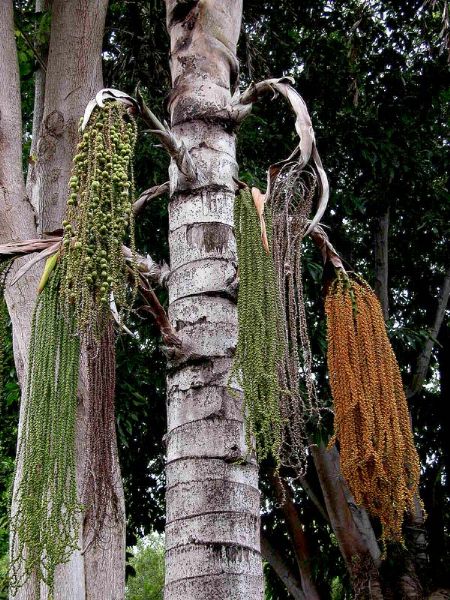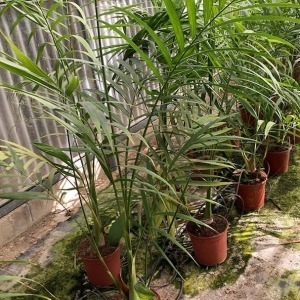Caryota urens
This is found in woody areas up to an altitude of 300 metres.
Known as the fishtail palm because of its leaves with dentate leaflets, it flowers and then produces fruit all along its trunk from the top to the bottom before dying having completed the process (monocarpic palm) .
It grows very rapidly in good growing conditions, with rich, well drained soil and high humidity. In lime- rich soil magnesium and microelements must be added.
It bears a great bunch of fruit which contains calcium oxalate and therefore can irritate the skin when handled.
They make a very popular alcoholic drink, called toddy, by fermenting its sap in the countries where this species is native.
Pot, (> 3,00 m.tr.)
We do not send plants by postage
GENERAL STATEMENT OF SPECIES
Botanic name
Name first recorded for the palm, genus and species, followed by the abbreviation of the specialist who described it.Common names
Local names used for this palm.Origin
Place in the world where this species spontaneously appears.Frequency in gardens
Frequency of this species in the gardens of south-west Europe. Very rare / Infrequent / Common / Very commonDESCRIPTION
Shape
Palms generally comprise one or several trunks that grow straight out of the ground, but in some species the trunk (or trunks) grow underground and/or as creepers.Leaves
of palmate (fan or costapalmate) or pinnate or feathery (pinnate or bi-pinnate) appearance.Total height
The height that the species can reach, in good cultivation conditions, in gardens of south-west Europe. – Less than 3 m. / Less than 6 m. / Less than 15 m. / More than 15 m.-Thorns
Indicates if the palm has thorns or spikes on the trunk, leaves and/or petioles.Diameter of the plant
Width or diameter to which the crown on the palm may grow when it is an adult. Less than 3 m. / Less than 6 m. / Less than 10 m. / Over 10 m.Crownshaft
Sometimes at the base of the leaves, there is a marked thickening around the trunk of the palm.Diameter of the trunk
Width or diameter which the trunk of the palm normally reaches when it is adult. Less than 30 cm. / Less than 15 cm. / Less than 30 cm./ Less than 50 cm. / Over 50 cm.-Gender
Some palms have bisexual flowers and/or male and female flowers (monoecious plants) on the same inflorescence. Other palms have flowers of both sexes on different plants (dioicous plants).).CULTURE
Minimum temperature
Minimum temperature at which an adult plant can survive the winter. The duration of these minimum temperatures and planting conditions will be decisive factors affecting the subsequent degree of damage suffered by the palm (extent of defoliation, strangulation of trunk, etc.).Soils
Some palms need fertile and well drained soils; others can grow in calcareous soils and even soils poor in organic matter, provided that they drain well (drained); other palms are very rustic and can grow in practically all types of soil, even in clay and poor soils.Growth rate
Speed at which the palm species grow in the gardens of southeast Europe in good cultivation conditions. Slow indicates annual trunk growth of less than 30 cm. Medium indicates a trunk growth of between 30 and 90 cm. Fast means they can grow more than one meter per year.Feeding
Light / Medium / StrongExposure
The degree of exposure to the sun that the palm needs to grow well.Use inside
Some palms are an excellent addition to home decor being in little need of light, water or humidity. Others are a good choice providing humidity and light are not poor. Other species, on the contrary, are not recommendable as they require good light and/or great humidity and/or have thorns in some parts.Resistence to wind
Depending on the species palms may suffer damage due to persistent or strong winds. Their resistance can be classified as Low / Medium / High.Pruning requierements
Some palms only retain those leaves which are no longer functional for a short time, soon dropping them and thus not requiring pruning. Other palms, depending on conditions of humidity and strength of winds where they live, may retain dead leaves, or the base of their petioles, on the trunk for many years.Drought resistance
In this guide, the palm species are classified according to their drought resistance (and tolerance to dry environments). -Low / Medium / High-.Difficulty transplanting
One of the advantages of palms is that large specimens can be transplanted with ease, a large rootball not being necessary, being able to fully recover within a year or a year and a half. (Low difficulty) Others may require a few more months to settle down in their new position. (Medium difficulty) and others still, on the contrary, may need over two years to recover from being transplanted (Greater difficulty).Salt tolerance
Low indicates that the palm does not tolerate salinity. Medium indicates that it can tolerate some salinity in irrigation water. HighGENERAL STATEMENT OF SPECIES
Botanic name
Name first recorded for the palm, genus and species, followed by the abbreviation of the specialist who described it.Common names
Local names used for this palm.Origin
Place in the world where this species spontaneously appears.Frequency in gardens
Frequency of this species in the gardens of south-west Europe. Very rare / Infrequent / Common / Very commonDESCRIPTION
Shape
Palms generally comprise one or several trunks that grow straight out of the ground, but in some species the trunk (or trunks) grow underground and/or as creepers.Leaves
of palmate (fan or costapalmate) or pinnate or feathery (pinnate or bi-pinnate) appearance.Total height
The height that the species can reach, in good cultivation conditions, in gardens of south-west Europe. – Less than 3 m. / Less than 6 m. / Less than 15 m. / More than 15 m.-Thorns
Indicates if the palm has thorns or spikes on the trunk, leaves and/or petioles.Diameter of the plant
Width or diameter to which the crown on the palm may grow when it is an adult. Less than 3 m. / Less than 6 m. / Less than 10 m. / Over 10 m.Crownshaft
Sometimes at the base of the leaves, there is a marked thickening around the trunk of the palm.Diameter of the trunk
Width or diameter which the trunk of the palm normally reaches when it is adult. Less than 30 cm. / Less than 15 cm. / Less than 30 cm./ Less than 50 cm. / Over 50 cm.-Gender
Some palms have bisexual flowers and/or male and female flowers (monoecious plants) on the same inflorescence. Other palms have flowers of both sexes on different plants (dioicous plants).).CULTURE
Minimum temperature
Minimum temperature at which an adult plant can survive the winter. The duration of these minimum temperatures and planting conditions will be decisive factors affecting the subsequent degree of damage suffered by the palm (extent of defoliation, strangulation of trunk, etc.).Soils
Some palms need fertile and well drained soils; others can grow in calcareous soils and even soils poor in organic matter, provided that they drain well (drained); other palms are very rustic and can grow in practically all types of soil, even in clay and poor soils.Growth rate
Speed at which the palm species grow in the gardens of southeast Europe in good cultivation conditions. Slow indicates annual trunk growth of less than 30 cm. Medium indicates a trunk growth of between 30 and 90 cm. Fast means they can grow more than one meter per year.Feeding
Light / Medium / StrongExposure
The degree of exposure to the sun that the palm needs to grow well.Use inside
Some palms are an excellent addition to home decor being in little need of light, water or humidity. Others are a good choice providing humidity and light are not poor. Other species, on the contrary, are not recommendable as they require good light and/or great humidity and/or have thorns in some parts.Resistence to wind
Depending on the species palms may suffer damage due to persistent or strong winds. Their resistance can be classified as Low / Medium / High.Pruning requierements
Some palms only retain those leaves which are no longer functional for a short time, soon dropping them and thus not requiring pruning. Other palms, depending on conditions of humidity and strength of winds where they live, may retain dead leaves, or the base of their petioles, on the trunk for many years.Drought resistance
In this guide, the palm species are classified according to their drought resistance (and tolerance to dry environments). -Low / Medium / High-.Difficulty transplanting
One of the advantages of palms is that large specimens can be transplanted with ease, a large rootball not being necessary, being able to fully recover within a year or a year and a half. (Low difficulty) Others may require a few more months to settle down in their new position. (Medium difficulty) and others still, on the contrary, may need over two years to recover from being transplanted (Greater difficulty).Salt tolerance
Low indicates that the palm does not tolerate salinity. Medium indicates that it can tolerate some salinity in irrigation water. High













